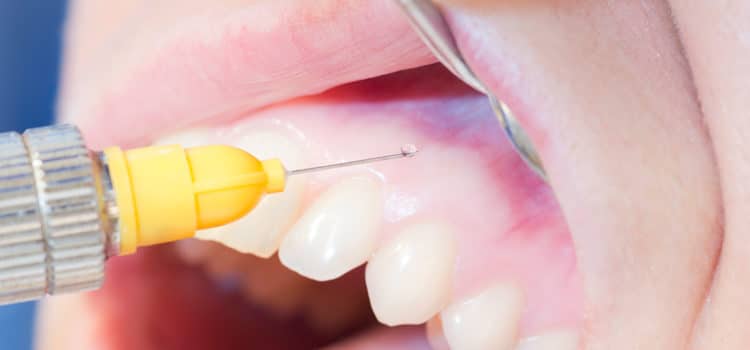
What’s New in Local Anesthesia
A brief update on important safety considerations when using local anesthesia.
Stanley F. Malamed, DDS, is dentistry’s best-known expert on local anesthesia and his book, Handbook of Local Anesthesia, has been the go-to guide for safe anesthesia practice in dentistry since the first edition was published in 1978. In 2012, the sixth edition of the handbook was released, revealing some changes on maximum recommended dosages (MRDs). In this interview with Dimensions of Dental Hygiene, Malamed discusses these differences, in addition to changes in anesthetic labeling and considerations for specific patient populations.
 The sixth edition of your book includes only the United States Food and Drug Administration (FDA) MRDs, as opposed to previous editions that also featured your own MRDs. Why did this change?
The sixth edition of your book includes only the United States Food and Drug Administration (FDA) MRDs, as opposed to previous editions that also featured your own MRDs. Why did this change?
The MRDs for currently available local anesthetics listed in the 5th edition of the Handbook of Local Anesthesia had two columns: FDA recommended MRDs and then my own MRDs.1 In some cases, the values in both columns were the same, but in others there were differences.
Usually, mine reflected slightly lower values. They were obtained from other authoritative sources and I felt they were quite reasonable, thus their inclusion. However, readers (especially teachers of local anesthesia in dental and dental hygiene programs) mentioned that having two sets of MRDs was confusing to both them and their students. Because the FDA sets the MRD standards, I decided that future editions (sixth and onward) would only present the FDA values.2 The only goal here was to try to avoid confusion. Interestingly, the American Academy of Pediatric Dentistry still lists the lower values in its monograph.3
Manufacturers’ drug data sheets now list the volume per cartridge as 1.7 mL. Should drug dose calculations reflect this volume or the traditional 1.8 mL volume that has been the basis for calculations for many years?
There has not been any change in the dental local anesthetic cartridge. The adjustment has been only in labeling. This initially occurred with the introduction of articaine in 2000. During discussions between the drug’s manufacturer and the FDA, the question of “truth in advertising” arose. The FDA asked the manufacturer if it could guarantee that every local anesthesia cartridge contained at least 1.8 mL of solution. Because cartridges are filled by machine, the answer was no.
The manufacturer could, however, guarantee that every local anesthesia cartridge contained at least 1.7 mL. Robertson et al published a paper in 2007 that assayed 50 lidocaine hydrochloride and 50 articaine hydrochloride cartridges, and found an average volume of 1.76 +/- 0.023 mL in each.4 My recommendation is to continue to use 1.8 mL as the cartridge volume when determining MRDs for patients.
Some sources suggest that prilocaine is contraindicated in pregnant patients due to its association with methemoglobinemia, and concerns regarding oxygenation and the fetus. What is your opinion?
Prilocaine’s MRD is based on the drug’s ability to increase the levels of methemoglobin (a type of hemoglobin) as it undergoes metabolism in the body. This is only a concern among patients with a history of congenital methemoglobinemia (a condition where methemoglobin levels are higher than normal).
Administering large prilocaine doses to such individuals can push them into the danger zone, which would result in respiratory distress and cyanosis of mucous membranes. Interestingly, the administration of oxygen to this patient would not prove very successful because his or her hemoglobin is not able to carry oxygen. As for pregnancy, prilocaine is not contraindicated, but its dosage should be kept minimal (as dosages should be with all local anesthetics in all clinical situations, not only during pregnancy).
Should topical anesthetics that contain prilocaine or benzocaine be avoided during pregnancy?
Prilocaine and benzocaine (a more commonly used topical anesthetic) can elevate methemoglobin levels in the blood. Large doses of either drug should be avoided during pregnancy. The use of other local anesthetics that do not produce elevations in methemoglobin levels is preferred.
What should dental hygienists consider when selecting between 4% articaine with 1:200,000 epinephrine or 4% articaine with 1:100,000 epinephrine?
Both of these formulations provide pulpal anesthesia of approximately 1-hour duration and soft tissue anesthesia up to about 5 hours, and these values are for patients exhibiting normal response (ie, in the middle of the bell curve). Selection is entirely up to the clinician administering the drug. Both formulations are effective and safe.
The use of vasoconstrictors should be restricted in patients who have taken methamphetamines or cocaine within 24 hours. Does the use of marijuana or any local anesthetic agents impact the selection, and, if so, for how long?
The reason for withholding vasoconstrictors from patients having taken methamphetamines or cocaine within 24 hours is fairly obvious—excessive stimulation of the cardiovascular system increases the risk of cardiac dysrhythmias, potentially leading to cardiac arrest. I do not believe this is a problem with marijuana use because it’s not a stimulant; rather it is a central nervous system depressant. To my knowledge, there are no cardiovascular stimulatory actions associated with cannabis.
References
- Malamed S. Handbook of Local Anesthesia. 5th ed. St Louis: Mosby; 2004.
- Malamed S. Handbook of Local Anesthesia. 6th ed. St Louis: Mosby; 2013.
- American Academy of Pediatric Dentistry. Guideline on Use of Local Anesthesia for Pediatric Dental Patients. Available at: www.aapd.org/ media/Policies_Guidelines/G_LocalAnesthesia.pdf. Accessed May 6, 2013.
- Robertson D, Nusstein J, Reader A, Beck M, McCartney M. The anesthetic efficacy of articaine in buccal infiltration of mandibular posterior teeth. J Am Dent Assoc. 2007;138:1104–1112.
From Dimensions of Dental Hygiene. July 2013; 11(7): 21–22.

